Page 151 of 772
151 1-6. Theft deterrent system
1
Before driving
AVENSIS_EE (OM20B44E)
Unstable items, such as dangling accessories or clothes hanging on the
coat hooks, are in the vehicle.
A window is open.
The vehicle is inside an automatic or high-pressure car washer.
The vehicle experiences impacts, such as hail, lightning strikes, or other
kinds of repeated impacts or vibrations.
The vehicle is parked in a place where
extreme vibrations or noises occur,
such as in a parking garage.
Ice or snow is removed from the vehi-
cle, causing the vehicle to receive
repeated impacts or vibrations.
The wind or something similar causes a
frost cover to move.
Page 157 of 772
157 1-7. Safety information
1
Before driving
AVENSIS_EE (OM20B44E)
Airbag system components
Front airbag sensor
Airbag manual on-off switch
Front passenger airbag
Side and curtain shield air-
bag sensor
Side airbag
Curtain shield airbagDriver airbag
Driver’s seat belt buckle
switch
Knee airbag
SRS warning light
“PASSENGER AIRBAG”
indicator light
Airbag sensor assembly
Side and curtain shield airbags
Side airbags
Can help protect the torso of the front seat occupants.
Curtain shield airbags
Can help protect primarily the head of front seat occupants and
rear outboard seat occupants.
Page 158 of 772

158 1-7. Safety information
AVENSIS_EE (OM20B44E)The main SRS airbag system components are shown. The SRS air-
bag system is controlled by the airbag sensor assembly. The airbag
sensor assembly consists of a safing sensor and an airbag sensor.
In certain types of severe frontal or side impacts, the SRS airbag sys-
tem triggers the airbag inflators. A chemical reaction in the inflators
quickly fills the airbags with non-toxic gas to help restrain the motion
of the occupants.
If the SRS airbags deploy (inflate)
Bruising and slight abrasions may result from contact with a deploying
(inflating) SRS airbag.
A loud noise and white powder will be emitted.
Parts of the airbag module (steering wheel hub, airbag cover and inflator)
as well as the front seats, front pillar and roof side rail, may be hot for
several minutes. The airbag itself may also be hot.
The windshield may crack.
Operating conditions (front airbags)
The SRS front airbag will deploy in the event of an impact that exceeds
the set threshold level (the level of force corresponding to an approxi-
mately 20 - 30 km/h [12 - 18 mph] frontal collision with a fixed wall that
does not move or deform).
However, this threshold velocity will be considerably higher if the vehicle
strikes an object, such as a parked vehicle or sign pole, which can move or
deform on impact, or if the vehicle is involved in an underride collision (e.g.
a collision in which the front of the vehicle “underrides”, or goes under, the
bed of a truck, etc.).
It is possible that in some collisions where the forward deceleration of the
vehicle is very close to the designed threshold level, the SRS front air-
bags and the seat belt pretensioners may not activate together.
Page 163 of 772
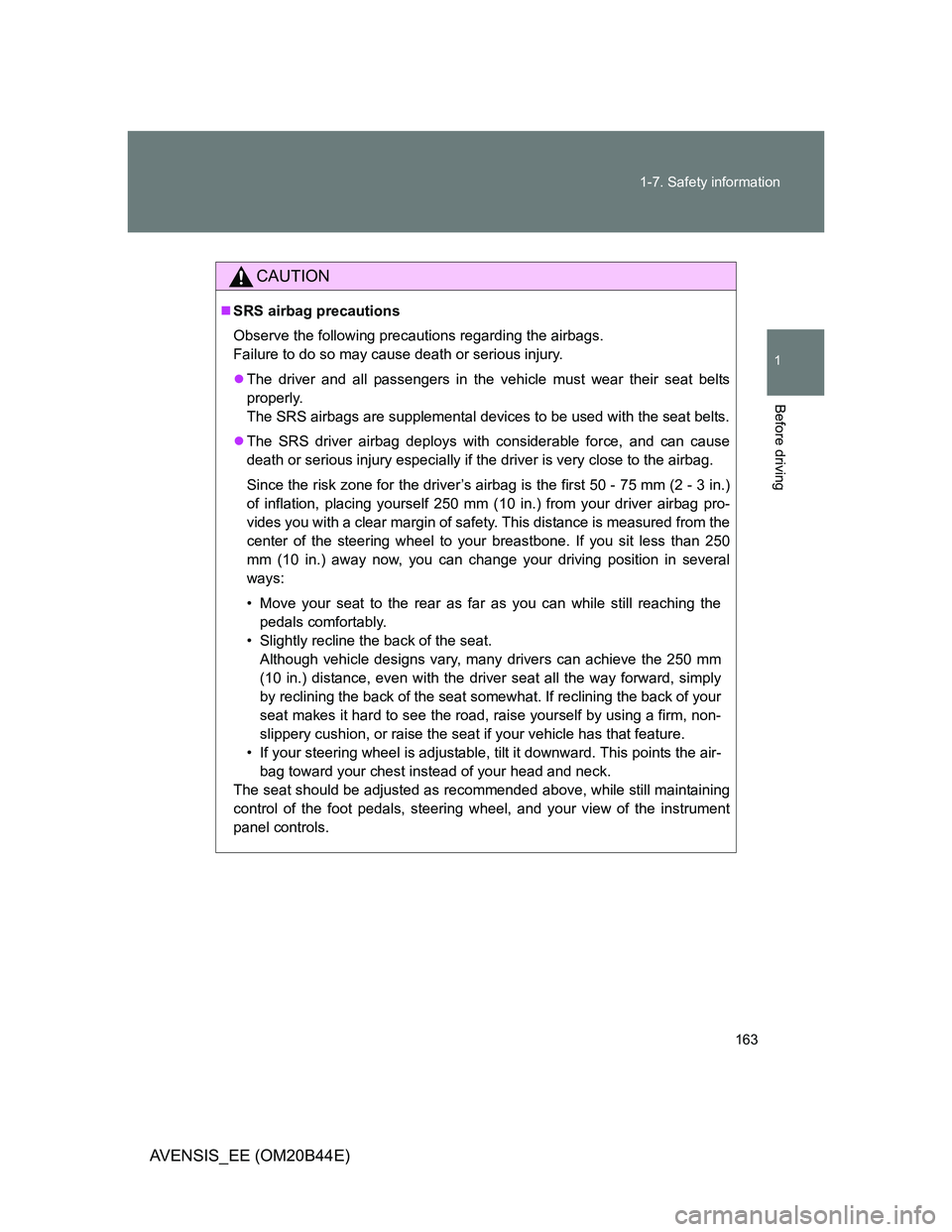
163 1-7. Safety information
1
Before driving
AVENSIS_EE (OM20B44E)
CAUTION
SRS airbag precautions
Observe the following precautions regarding the airbags.
Failure to do so may cause death or serious injury.
The driver and all passengers in the vehicle must wear their seat belts
properly.
The SRS airbags are supplemental devices to be used with the seat belts.
The SRS driver airbag deploys with considerable force, and can cause
death or serious injury especially if the driver is very close to the airbag.
Since the risk zone for the driver’s airbag is the first 50 - 75 mm (2 - 3 in.)
of inflation, placing yourself 250 mm (10 in.) from your driver airbag pro-
vides you with a clear margin of safety. This distance is measured from the
center of the steering wheel to your breastbone. If you sit less than 250
mm (10 in.) away now, you can change your driving position in several
ways:
• Move your seat to the rear as far as you can while still reaching the
pedals comfortably.
• Slightly recline the back of the seat.
Although vehicle designs vary, many drivers can achieve the 250 mm
(10 in.) distance, even with the driver seat all the way forward, simply
by reclining the back of the seat somewhat. If reclining the back of your
seat makes it hard to see the road, raise yourself by using a firm, non-
slippery cushion, or raise the seat if your vehicle has that feature.
• If your steering wheel is adjustable, tilt it downward. This points the air-
bag toward your chest instead of your head and neck.
The seat should be adjusted as recommended above, while still maintaining
control of the foot pedals, steering wheel, and your view of the instrument
panel controls.
Page 193 of 772
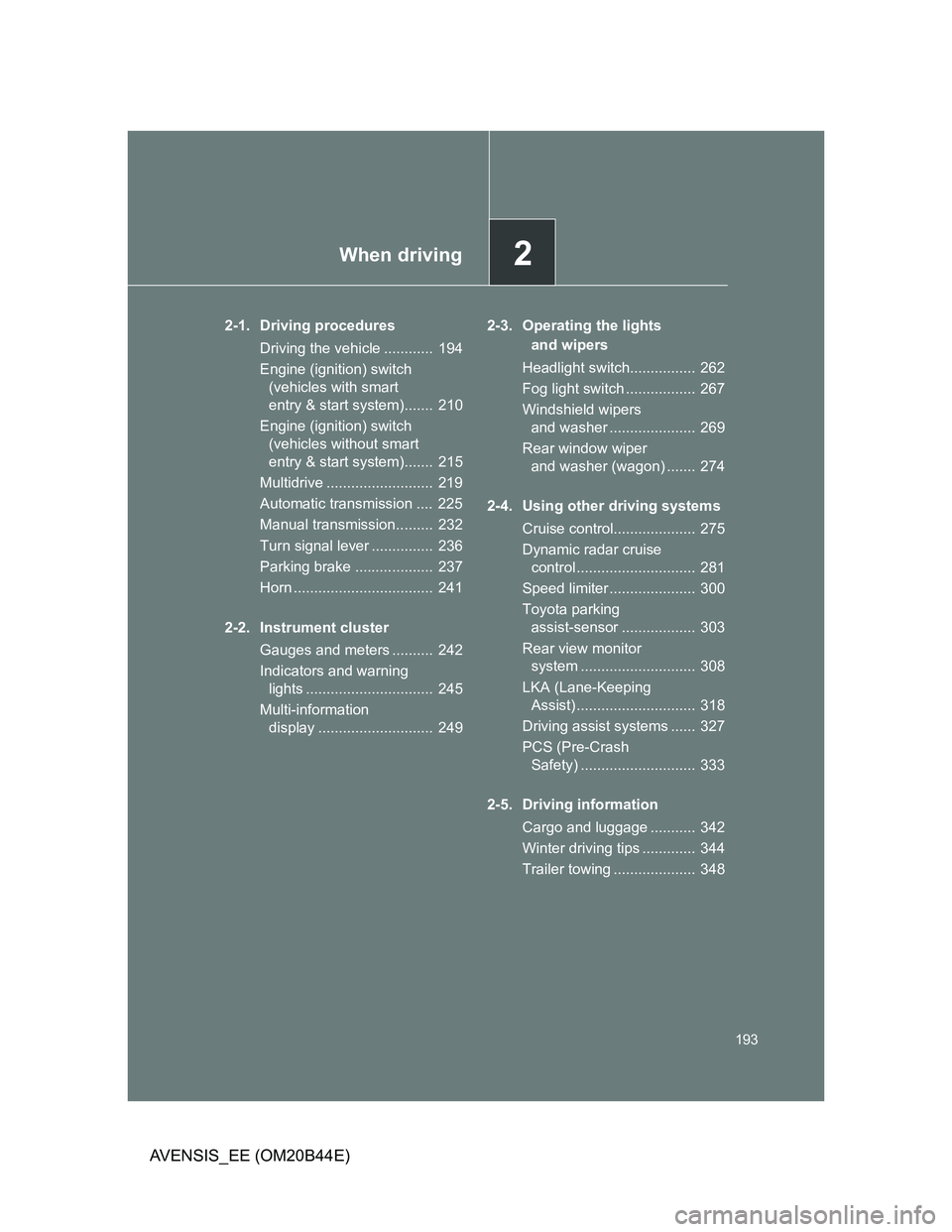
2When driving
193
AVENSIS_EE (OM20B44E)
2-1. Driving procedures
Driving the vehicle ............ 194
Engine (ignition) switch
(vehicles with smart
entry & start system)....... 210
Engine (ignition) switch
(vehicles without smart
entry & start system)....... 215
Multidrive .......................... 219
Automatic transmission .... 225
Manual transmission......... 232
Turn signal lever ............... 236
Parking brake ................... 237
Horn .................................. 241
2-2. Instrument cluster
Gauges and meters .......... 242
Indicators and warning
lights ............................... 245
Multi-information
display ............................ 2492-3. Operating the lights
and wipers
Headlight switch................ 262
Fog light switch ................. 267
Windshield wipers
and washer ..................... 269
Rear window wiper
and washer (wagon) ....... 274
2-4. Using other driving systems
Cruise control.................... 275
Dynamic radar cruise
control ............................. 281
Speed limiter ..................... 300
Toyota parking
assist-sensor .................. 303
Rear view monitor
system ............................ 308
LKA (Lane-Keeping
Assist) ............................. 318
Driving assist systems ...... 327
PCS (Pre-Crash
Safety) ............................ 333
2-5. Driving information
Cargo and luggage ........... 342
Winter driving tips ............. 344
Trailer towing .................... 348
Page 197 of 772
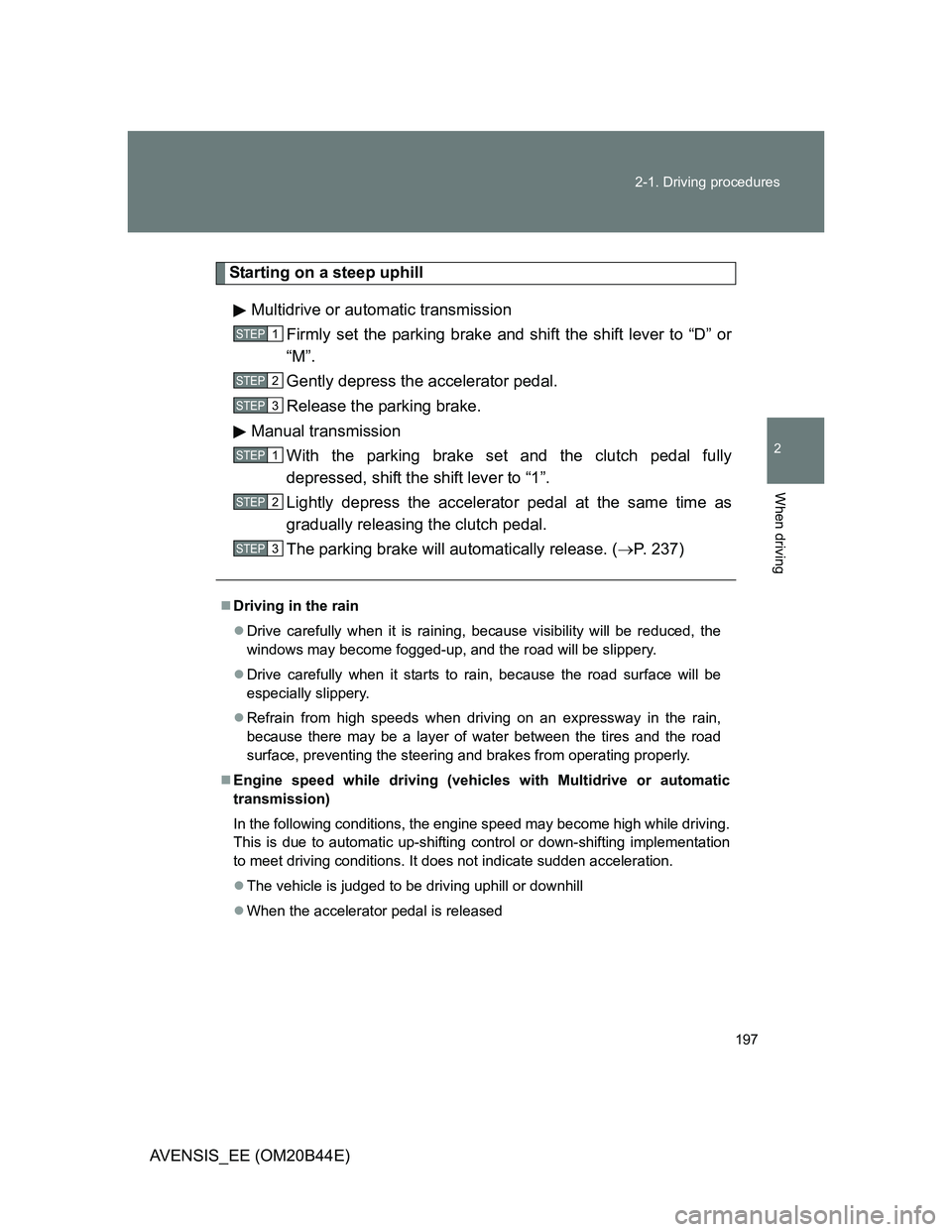
197 2-1. Driving procedures
2
When driving
AVENSIS_EE (OM20B44E)
Starting on a steep uphill
Multidrive or automatic transmission
Firmly set the parking brake and shift the shift lever to “D” or
“M”.
Gently depress the accelerator pedal.
Release the parking brake.
Manual transmission
With the parking brake set and the clutch pedal fully
depressed, shift the shift lever to “1”.
Lightly depress the accelerator pedal at the same time as
gradually releasing the clutch pedal.
The parking brake will automatically release. (P. 237)
Driving in the rain
Drive carefully when it is raining, because visibility will be reduced, the
windows may become fogged-up, and the road will be slippery.
Drive carefully when it starts to rain, because the road surface will be
especially slippery.
Refrain from high speeds when driving on an expressway in the rain,
because there may be a layer of water between the tires and the road
surface, preventing the steering and brakes from operating properly.
Engine speed while driving (vehicles with Multidrive or automatic
transmission)
In the following conditions, the engine speed may become high while driving.
This is due to automatic up-shifting control or down-shifting implementation
to meet driving conditions. It does not indicate sudden acceleration.
The vehicle is judged to be driving uphill or downhill
When the accelerator pedal is released
STEP1
STEP2
STEP3
STEP1
STEP2
STEP3
Page 198 of 772
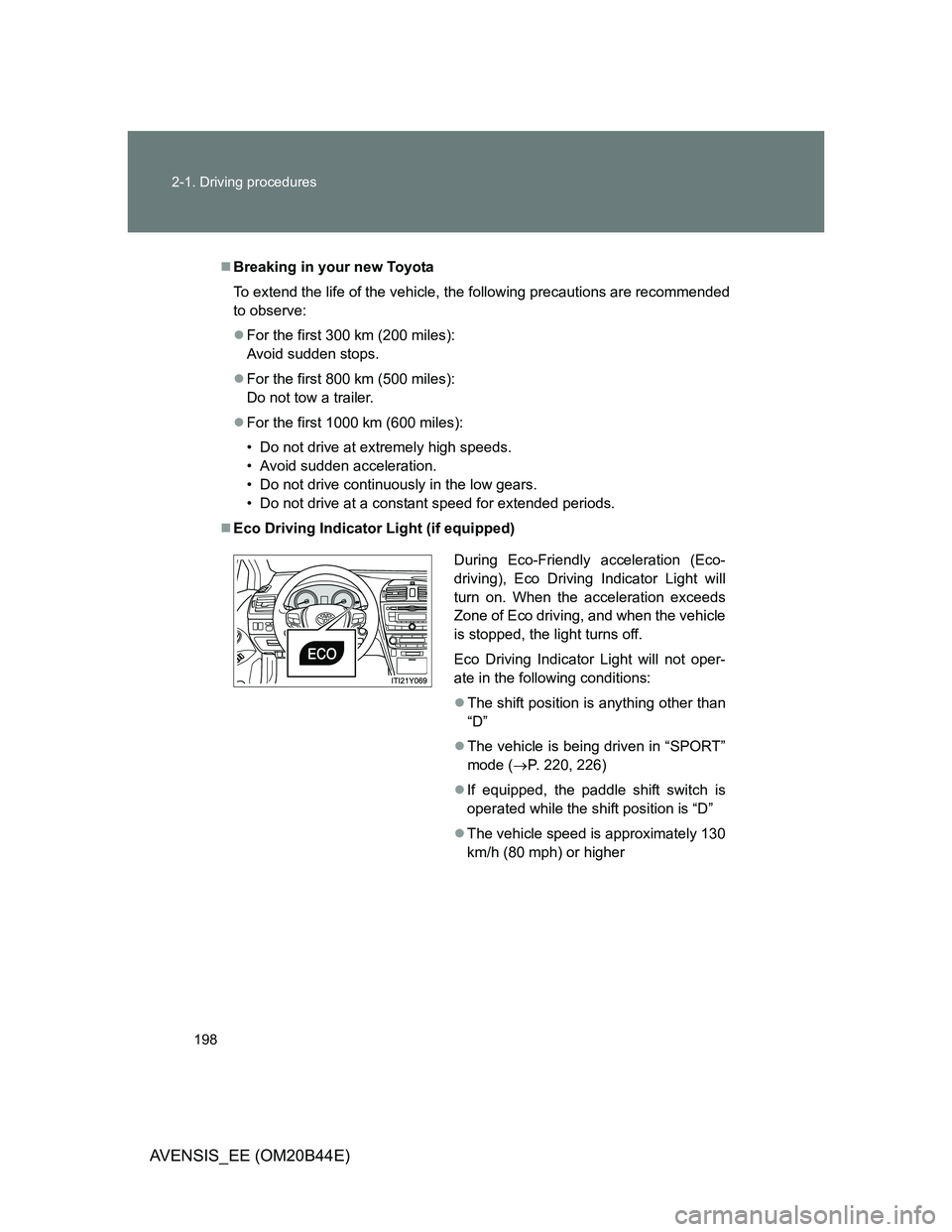
198 2-1. Driving procedures
AVENSIS_EE (OM20B44E)
Breaking in your new Toyota
To extend the life of the vehicle, the following precautions are recommended
to observe:
For the first 300 km (200 miles):
Avoid sudden stops.
For the first 800 km (500 miles):
Do not tow a trailer.
For the first 1000 km (600 miles):
• Do not drive at extremely high speeds.
• Avoid sudden acceleration.
• Do not drive continuously in the low gears.
• Do not drive at a constant speed for extended periods.
Eco Driving Indicator Light (if equipped)
During Eco-Friendly acceleration (Eco-
driving), Eco Driving Indicator Light will
turn on. When the acceleration exceeds
Zone of Eco driving, and when the vehicle
is stopped, the light turns off.
Eco Driving Indicator Light will not oper-
ate in the following conditions:
The shift position is anything other than
“D”
The vehicle is being driven in “SPORT”
mode (P. 220, 226)
If equipped, the paddle shift switch is
operated while the shift position is “D”
The vehicle speed is approximately 130
km/h (80 mph) or higher
Page 200 of 772
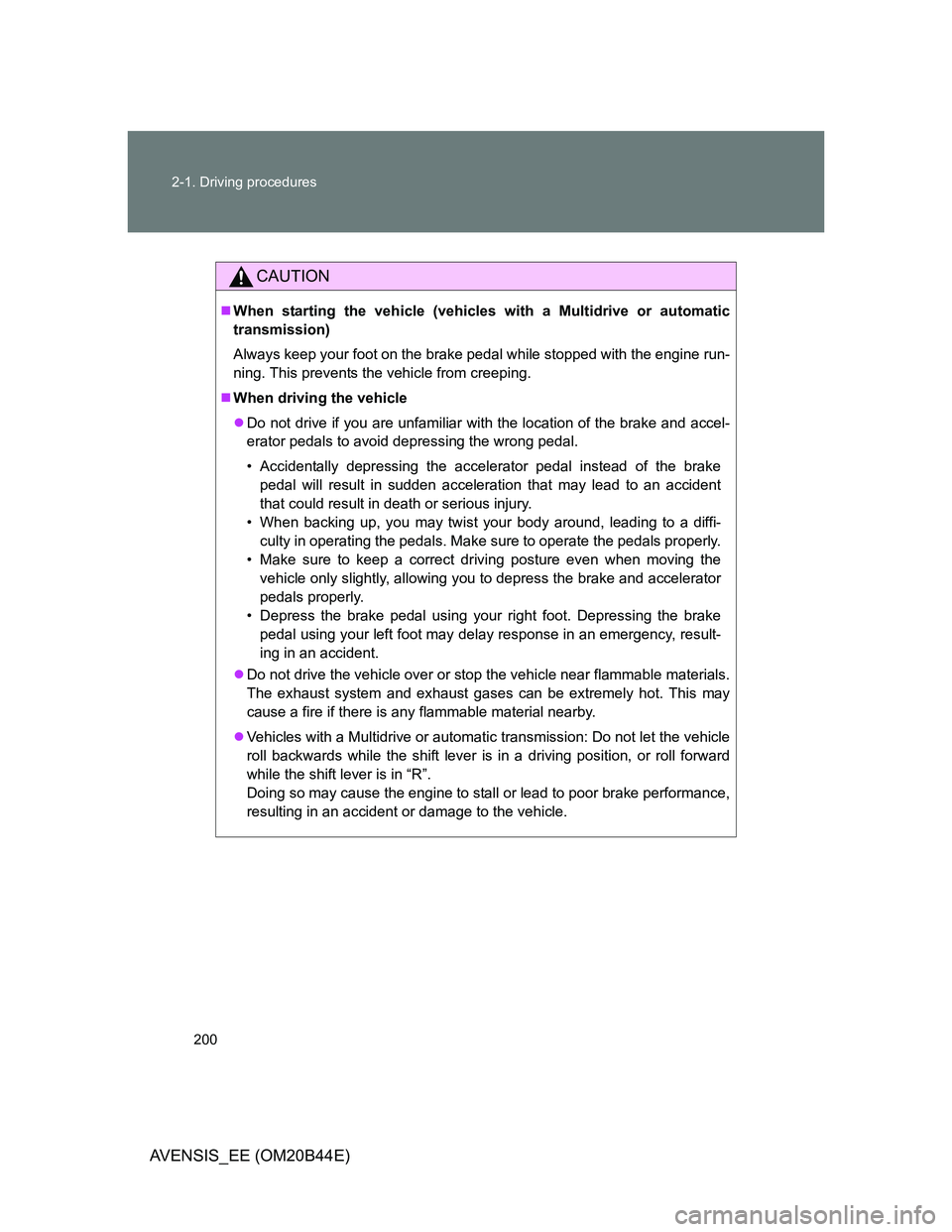
200 2-1. Driving procedures
AVENSIS_EE (OM20B44E)
CAUTION
When starting the vehicle (vehicles with a Multidrive or automatic
transmission)
Always keep your foot on the brake pedal while stopped with the engine run-
ning. This prevents the vehicle from creeping.
When driving the vehicle
Do not drive if you are unfamiliar with the location of the brake and accel-
erator pedals to avoid depressing the wrong pedal.
• Accidentally depressing the accelerator pedal instead of the brake
pedal will result in sudden acceleration that may lead to an accident
that could result in death or serious injury.
• When backing up, you may twist your body around, leading to a diffi-
culty in operating the pedals. Make sure to operate the pedals properly.
• Make sure to keep a correct driving posture even when moving the
vehicle only slightly, allowing you to depress the brake and accelerator
pedals properly.
• Depress the brake pedal using your right foot. Depressing the brake
pedal using your left foot may delay response in an emergency, result-
ing in an accident.
Do not drive the vehicle over or stop the vehicle near flammable materials.
The exhaust system and exhaust gases can be extremely hot. This may
cause a fire if there is any flammable material nearby.
Vehicles with a Multidrive or automatic transmission: Do not let the vehicle
roll backwards while the shift lever is in a driving position, or roll forward
while the shift lever is in “R”.
Doing so may cause the engine to stall or lead to poor brake performance,
resulting in an accident or damage to the vehicle.